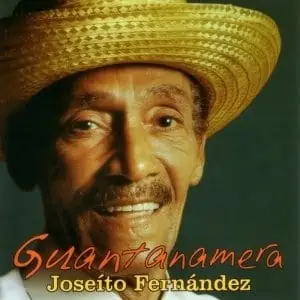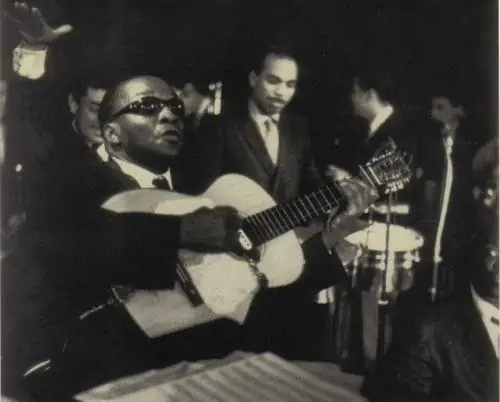In this episode, I dug up an old class I took in Havana Cuba with Andres Rodriguez discussing Cuban son and it’s origins.
This was likely recorded on a very bad DAT or Cassette recorder but it is what it is. Hopefully there is some use for you.
Transcript
Alen:
Okay. Now, we can begin speaking about Cuban Masters Series – Cuban Tres
. The thing is to know where it came from, very generally speaking. Now, son … I would like to explain some things that there is a lot of confusion about. When was the first … when did … son was born. And also there is a lot of mistakes that very recently Cuban historians and people who dedicate themselves to gather this information have discovered there’s a lot of mistakes on books written many years ago.
Alen:
Maybe you have heard that the first Cuban Son was something like El Son de la Ma Teodora. This is very common. You can hear this everywhere, El Son de la Ma Teodora. Son de la Ma … This means mother, Mother Teodora, La Ma Teodora. It’s called … It says nobody can actually say which is the exact date for the birth of son but during a very large period of time, history … the Cuban historians said that it … There was a document published in 1893 by Laureano Fuentes where he said that this Son de la Ma Teodora was the first son. It was composed by two sisters, Micaela and Teodora Gines. These were the two sisters. They were two nuns. Teodora was the one who wrote this song or anyway one of them two … The two sisters wrote Son de la Ma Teodora. So they say this happened as far away as in the 16th century. Good.
Alen:
Nowadays, we know this is a great mistake because what is important to know is that Cuban nationality and Cuban culture only was born on the second half of the 18th century. Before that there was no Cuban culture. So this is a big mistake. And now, what we … most of the people who do research, they say that they doubt that Son de la Ma Teodora existed at all. They think that this was a mistake by Laureano Fuentes taking a tune of last century … that was last century that sounded in some ways a variation of [inaudible 00:03:05]. He made a mistake. Even they felt that Teodora Gines ever existed herself. Yet, nothing is for sure. I say because you are going to be reading a lot of books and maybe even in, I don’t know, movies and things, this Son de la Ma Teodora. Now, we say it’s not true.
Alen:
Now, the real truth is that son begins in the countryside and very specifically in the mountains. This is one thing in theory. Another one is that they have a … It was born in many places of the country at the same time. But everybody agrees that this happened on the second half of the 18th century.
Alen:
And, now, we’re going to hear an example of son Sierra Maestra. Sierra Maestra is our biggest, highest mountains. And deep inside each woods, the mountains, these are recordings I’ve taken. It’s a party. It’s named nengon, nengon, nengon. Nengon is one of the names for son. You’ll hear there’s a … Changui is another name for a style of son and so on. So you can hear … That’s why son is a big group of different dances. Let’s hear this. Note how the transition from this African came to this. It’s very interesting. (music). It sounds African. [inaudible 00:04:48] the first son. [inaudible 00:04:56].
Speaker 2:
[inaudible 00:05:14]?
Alen:
No. It’s a tres [inaudible 00:05:17].
Speaker 2:
[inaudible 00:05:26].
Alen:
No. There is [inaudible 00:05:22].
Speaker 2:
[inaudible 00:05:27].
Alen:
Maybe [inaudible 00:05:33]. Note he says that when you hear the recording well you can hear [inaudible 00:05:36] also. Here it sounds very [inaudible 00:05:41]. Okay. We got to get a better recording [inaudible 00:05:49]. Okay. Okay.
Alen:
So, now, we have [inaudible 00:06:13] son. Now, son expanded to the whole territory in a very fast way. Not only through Cuba, it reached also Isla [inaudible 00:06:32]. It’s a small island we have. It’s part of Cuba. And also Santo Domingo and Puerto Rico also it reached. In this area the son have the musical form of a round dance. And it took from the Africans the solo and the refrain, the chorus.
Speaker 2:
[crosstalk 00:06:56]-
Alen:
And it mixed up … What?
Speaker 2:
That’s often referred to as call and response.
Alen:
Call and response. Yes, also. Okay. Call and response. But the call and response it can be made by two soloists.
Speaker 2:
So-
Alen:
So you have to have a solo and a group.
Speaker 2:
[inaudible 00:07:15].
Alen:
That’s the Africans.
Speaker 2:
Yeah.
Alen:
And also it got mixed up … what, with this alternation of solo and call. And it took the percussion instruments from the Africans and it took the guitars [inaudible 00:07:37], different types of string instruments, [inaudible 00:07:39] guitar and also tres, which is a Cuban version of the Spanish guitar. I’ll explain later what’s the difference. And we have, now, son. With all these mixings we have a new example of son. It’s very interesting this one. Now, we can hear the whole mixing. (music).
Speaker 2:
Seems exactly the same rhythm.
Alen:
But, now, we have the son [inaudible 00:08:09]. I think the examples are good. [inaudible 00:08:45]. Okay. [inaudible 00:09:57]. Now, of course, we have two choices because unluckily we need more time because I’m trying to do today son and danzon at least, because we have five groups, as fast as we can. Now, what is [inaudible 00:10:17]? The rest of it, what is now the more modern examples. After this, you can begin speaking about Benny More. You can hear Ben More. I have some examples. But we don’t have time. We don’t have time. But I think it’s already an introduction to son, I think. So what I suggest is to skip to danzon now, to do the same, to do the same just to … Now, danzon-
Speaker 3:
I have a question now.
Alen:
Yes.
Speaker 3:
Can you just explain how this kind of tumba developed, what you can hear on this recording in son?
Alen:
That would take … I know. I know. That’s what I do on piano lessons. Because if we do that you see tumba is quite different on each instrument. So I think tumba … It’s a question that is better solved on the instrument classes.
Speaker 2:
Yes. Also-
Alen:
Because it’s not the same tumba on guitars and in piano and so on.
Speaker 4:
[inaudible 00:11:18].
Alen:
But we can do that in some moment. But really it will take … It would take a lot of time. I don’t think-
Speaker 2:
Also [inaudible 00:11:25] concepts, which is starting tomorrow, which is also [inaudible 00:11:29]. They explain a lot of that. [inaudible 00:11:31].
Alen:
The purpose of this is to make a general overview, you see. That’s what we’re trying to do, to gather things up and then we go through specifically.
Speaker 2:
You mentioned the different names for different subcategories of son, the nengon and the changui-
Alen:
Yes. Nengon, changui, for example.
Speaker 2:
Were those correspond to different-
Alen:
Sucu-sucu also, that’s another one.
Speaker 2:
… geographical areas?
Alen:
Yes. Yes.
Speaker 2:
And then-
Alen:
Sucu-sucu, for example, is Latinos. Nengon is on the eastern side of the country in Sierra Maestra, for example. Changui also on the eastern provinces.
Speaker 2:
Do they use different instruments in different areas?
Alen:
Also, they have different instruments depending on what are the instruments of the immigrations. Sometimes it’s a little bit more Spanish. Sometimes it’s a little bit more French. Because we have tumba francesa from Haiti. Even British from [inaudible 00:12:33] we have the people living here. It’s very [inaudible 00:12:37]. But, yes, there is [inaudible 00:12:39]. Now, the second [inaudible 00:12:43] …
Podcast: Play in new window | Download
Podcast: Play in new window | Download


